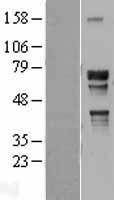order histories, retained contact details for faster checkout, review submissions, and special promotions.
Forgot password?
order histories, retained contact details for faster checkout, review submissions, and special promotions.
Locations
Orders Processing,
Shipping & Receiving,
Warehouse
2 Shaker Rd Suites
B001/B101
Shirley, MA 01464
Production Lab
Floor 6, Suite 620
20700 44th Avenue W
Lynnwood, WA 98036
Telephone Numbers
Tel: +1 (206) 374-1102
Fax: +1 (206) 577-4565
Contact Us
Additional Contact Details
order histories, retained contact details for faster checkout, review submissions, and special promotions.
Forgot password?
order histories, retained contact details for faster checkout, review submissions, and special promotions.
NR2C2 / TAK1
nuclear receptor subfamily 2, group C, member 2
Orphan nuclear receptor that can act as a repressor or activator of transcription. An important repressor of nuclear receptor signaling pathways such as retinoic acid receptor, retinoid X, vitamin D3 receptor, thyroid hormone receptor and estrogen receptor pathways. May regulate gene expression during the late phase of spermatogenesis. Together with NR2C1, forms the core of the DRED (direct repeat erythroid-definitive) complex that represses embryonic and fetal globin transcription including that of GATA1. Binds to hormone response elements (HREs) consisting of two 5'-AGGTCA-3' half site direct repeat consensus sequences. Plays a fundamental role in early embryonic development and embryonic stem cells. Required for normal spermatogenesis and cerebellum development. Appears to be important for neurodevelopmentally regulated behavior (By similarity). Activates transcriptional activity of LHCG. Antagonist of PPARA-mediated transactivation.
| Gene Name: | nuclear receptor subfamily 2, group C, member 2 |
| Family/Subfamily: | NHR , NR2 Hepatocyte NF4-like |
| Synonyms: | NR2C2, Nuclear hormone receptor TR4, Nuclear receptor TAK1, Orphan nuclear receptor TR4, Orphan nuclear receptor TAK1, Testicular orphan receptor-4, TR2R1, TR4, Testicular nuclear receptor 4, Testicular receptor 4, TR4 nuclear hormone receptor, HTAK1, Nuclear receptor tr4, TAK1 |
| Target Sequences: | NM_003298 NP_003289.2 P49116 |







If you do not find the reagent or information you require, please contact Customer.Support@LSBio.com to inquire about additional products in development.









